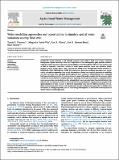Por favor, use este identificador para citar o enlazar a este item:
http://hdl.handle.net/10261/227227COMPARTIR / EXPORTAR:
 SHARE
BASE SHARE
BASE
|
|
| Visualizar otros formatos: MARC | Dublin Core | RDF | ORE | MODS | METS | DIDL | DATACITE | |

| Título: | Water modelling approaches and opportunities to simulate spatial water variations at crop field level |
Autor: | Tenreiro, Tomás R.; García Vila, Margarita CSIC ORCID; Gómez Calero, José Alfonso CSIC ORCID ; Jiménez-Berni, José A. ; Fereres Castiel, Elías CSIC ORCID | Palabras clave: | Crop-modelling Water-balance Spatial modelling Water management Precision agriculture |
Fecha de publicación: | 1-oct-2020 | Editor: | Elsevier | Citación: | Agricultural Water Management 240: 106254 (2020) | Resumen: | Considerable spatial variability in soil hydraulic properties exists within a field, even in those considered homogeneous. Spatial variability of water as a major driver of crop heterogeneity gains particular relevance within the context of precision agriculture, but modelling has devoted insufficient efforts to scale up from point to field the associated ‘cause-effect’ relations of water spatial variations. Seven crop simulation models (WOFOST, DSSAT, APSIM, DAISY, STICS, AquaCrop and MONICA) and five hydrologic models (HYDRUS-1D, HYDRUS-2D, SWAP, MIKE-SHE and SWIM) were selected and their water modelling approaches were systematically reviewed for comparison. Crop models rely mainly on ‘discrete’ and empirical approaches for modelling soil water movement while hydrologic models emphasize more ‘continuous’ and mechanistic ones. Combining both types of models may not be the best way forward as none of the models consider all of the processes which are relevant for the simulation of spatial variations. Hydrologic models pay more attention to spatially variable water processes than crop simulation models, although their focus is on scales higher than the field which is the relevant scale for assessing the influence of such variations on crop behaviour. Opportunities for progress in the spatial simulation of water processes at field level will probably come from two different directions. One implying a stronger synergism between both model families by using continuous-type approaches to simulate some mechanisms in existing crop models, and the other through the integration of lateral flows in the simulation of discrete water movement approaches. | Versión del editor: | http://doi.org/10.1016/j.agwat.2020.106254 | URI: | http://hdl.handle.net/10261/227227 | DOI: | 10.1016/j.agwat.2020.106254 | Identificadores: | doi: 10.1016/j.agwat.2020.106254 issn: 0378-3774 |
| Aparece en las colecciones: | (IAS) Artículos |
Ficheros en este ítem:
| Fichero | Descripción | Tamaño | Formato | |
|---|---|---|---|---|
| crop_field_level.pdf | 4,23 MB | Adobe PDF |  Visualizar/Abrir |
CORE Recommender
Page view(s)
158
checked on 22-abr-2024
Download(s)
265
checked on 22-abr-2024
Google ScholarTM
Check
Altmetric
Altmetric
Este item está licenciado bajo una Licencia Creative Commons

